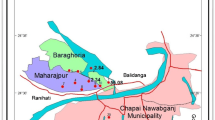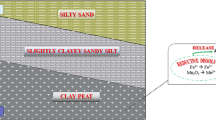Abstract
Core sediments from two boreholes and groundwater from fifty four As-contaminated well waters were collected in the Chapai-Nawabganj area of northwestern Bangladesh for geochemical analysis. Groundwater arsenic concentrations in the uppermost aquifer (10 to 40 m of depth) range from 2.76–315.15 mg/l (average 48.81 mg/l). Arsenic concentration in sediments ranges from 3.26–10 mg/kg. Vertical distribution of arsenic in both groundwater and sediments shows that maximum As concentration (462 mg/l in groundwater and 10 mg/kg in sediments) occurs at a depth of 24 m. In January 2008, 2009 and 2010, maximum As concentration occurs at the same depth. Environmental scanning electron microscope (ESEM) with EDAX was used to investigate the presence of major and trace elements in the sediments. The dominant groundwater type is Ca-HCO3 with high concentrations of As and Fe, but with low levels of NO3 − and SO3 −2. Statistical analysis clearly shows that As is closely associated with Fe (R2 = 0.64) and Mn (R2 = 0.91) in sediments while As is not correlated with Fe and Mn in groundwater samples. Comparatively low Fe and Mn concentrations in some groundwater, suggest that probably siderite and/or rhodochrosite precipitated as secondary mineral on the surface of the sediment particles. The correlations along with results of sequential leaching experiments suggest that reductive dissolution of FeOOH and MnOOH mediated by anaerobic bacteria represents mechanism for releasing arsenic into the groundwater.
Similar content being viewed by others
References
Ahmed, K.M., Bhattacharya, P., Hasan, M.A., Akhter, S.H., Alam, S.M.M., Bhuyian, M.A.H., Imam, M.B., Khan, A.A. and Sracek, O. (2004) Arsenic enrichment in groundwater of the alluvial aquifers in Bangladesh: an overview. Appld. Geochem., v.19, pp.181–200.
Anawar, H.M., Akai, J., Komaki, K., Terao, H., Yoshioka, T., Ishizuka, T., Safiullah, S. and Kato, K. (2003) Geochemical occurrence of arsenic in groundwater of Bangladesh: sources and mobilization processes. Jour. Geochem. Explor., v.77, pp.109–131.
BGS and DPHE (2001) Arsenic Contamination of Groundwater in Bangladesh. Vol. 2. Final Report, BGS Technical Report WC/00/19.
Bhattacharya, P. (2002) Arsenic contaminated groundwater from the sedimentary aquifers of South-East Asia. In: E. Bocanegra, D. Martinez and H. Massone (Eds.), Groundwaterand Human Development, Proc. XXXII IAH and VI ALHSUD Congress, Mar del Plata, Argentina, 21–25 October 2002, pp.357–363.
Bhattacharya, P., Frisbie, S.H., Smith, E., Naidu, R., Jacks, G. and Sarkar, B. (2002a). Arsenic in the environment: a global perspective. In: B. Sarkar (Ed.), Handbook of Heavy Metals in the Environment. Marcell Dekker Inc., New York, pp.147–215.
Bhattacharya, P., Jacks, G., Ahmed, K.M., Khan, A.A. and Routh, J. (2002b) Arsenic in groundwater of the Bengal Delta Plain aquifers in Bangladesh. Bull. Environ. Contam. Toxicol., v.69, pp.538–545.
Broms, S. and Fogelstrom, J. (2001) Field Investigations of Arsenic-Rich Groundwater in the Bengal Delta Plain, Bangladesh. MSc thesis, Series 2001:18, Department of Land and Water Resources Engineering, KTH, Stockholm.
Fabian, D., Zhou, Z., Wehrli, B. and Friedl, G. (2003). Diagenetic cycling of arsenic in the sediments of eutrophic Baldeggersee, Switzerland. Appld. Geochem., v.18, pp.1497–1506.
Islam F.S., Gault A.G., Boothman C., Polya D.A., Charnock J.M., Chatterjee D. and Lloyd, J.R. (2004) Role of metal-reducing bacteria in As release from Bengal delta sediments. Nature, v.430, pp.68–71.
Lee, M.-K., Saunders, J.A., Wilkin, R.T. and Mohammad, S. (2005) Geochemical modeling of arsenic speciation and mobilization: Implications for bioremediation, in Advances in Arsenic Research: Integration of Experimental and Observational Studies and Implications for Mitigation. O’Day et al. (Eds.), American Chemical Society Symposium Series, no.915, pp.398–413.
Mcarthur, J.M., Ravencroft, P., Safiullah, S. and Thirlwall, M.F. (2001). Arsenic in groundwater: testing pollution mechanism for sedimentary aquifers in Bangladesh. Water Resources Res., v.37, pp.109–117.
Nickson, R.T., Mcarthur, J.M., Ravenscroft, P., Burgess, W.G. and Ahmed, K.M. (2000) Mechanism of arsenic release to groundwater, Bangladesh and West Bengal. Appld. Geochem., v.15, pp.403–413.
Peltier, E.F., Webb, S.M. and Gaillard, J.F. (2003) Zinc and lead sequestration in an impacted wetland system. Adv. Environ. Res., v.8, pp.103–112.
Polizzotto, M.L., Kocar, B.D., Benner, S.G., Sampson, M. and Fendorf, S. (2008). Near-surface wetland sediments as a source of arsenic release to ground water in Asia. Nature, v.454, pp.505–508.
Ravenscroft, P. (2001) Distribution of groundwater arsenic in Bangladesh related to geology. In: G. Jacks P. Bhattacharya and A.A. Khan (Eds.), Groundwater Arsenic Contamination in the Bengal Delta Plains of Bangladesh. Proc. KTH-Dhaka University Seminar. KTH Special Publication, TRITA-AMI Report 3084, pp.41–56.
Reza, A.H.M.S., Jean, J.-S., Yang, H.-J., Lee, M.-K., Woodall, B., Liu, C.-C., Lee, J.-F. and Luo, S.-D. (2010) Occurrence of arsenic in core sediments and groundwater in the Chapai-Nawabganj district, northwestern Bangladesh. Water Research, v.44, pp.2021–2037.
Saha, S.K., Kumar, U. and Rahman, M. (2009) An assessment of groundwater chemistry of Barind Tract in Bangladesh with special reference to carbonate weathering. Asian Jour. Water Environ. Pollut., v.6, pp.51–58.
Saunders, J.A., Lee, M.-K., Uddin, A., Mohammad, S., Wilkin, R.T., Fayek, M. and Korte N.E. (2005) Natural arsenic contamination of Holocene alluvial aquifers by linked tectonic, weathering, and microbial processes. Geochemistry, Geophysics and Geosystems 6: doi:10.1029/2004GC000803.
Shamsudduha, M., Uddin, A., Saunders, J.A. and Lee, M.K. (2008) Quaternary stratigraphy, sediment characteristics and geochemistry of arsenic-contaminated alluvial aquifers in the Ganges-Brahmaputra floodplain in central Bangladesh. Jour. Contam. Hydrol., v.99, pp.112–136.
Smedley, P.L. and Kinniburgh, D.G. (2002) A review of the source, behavior and distribution of arsenic in natural waters. Appl. Geochem., v.17, pp.517–568.
Stollenwerk, K.G., Breit, G.N., Welch, A.H., Yount, J.C., Whitney, J.W., Foster, A.L., Uddin, M.N., Majumder, R.K. and Ahmed N. (2007) Arsenic attenuation by oxidized aquifer sediments in Bangladesh. Science of the Total Environment, v.379, pp.133–150.
Zheng, Y., Van Geen, A., Gavrieli, A., Dhar, R., Simpson, J. and Ahmed K.M. (2004) Redox control of arsenic mobilization in Bangladesh groundwater. Appl. Geochem., v.19, pp.201–214.
Author information
Authors and Affiliations
Corresponding author
Rights and permissions
About this article
Cite this article
Selim Reza, A.H.M., Jean, JS. Vertical distribution and mobilization of arsenic in shallow alluvial aquifers of Chapai-Nawabganj district, Northwestern Bangladesh. J Geol Soc India 80, 531–538 (2012). https://doi.org/10.1007/s12594-012-0173-1
Received:
Accepted:
Published:
Issue Date:
DOI: https://doi.org/10.1007/s12594-012-0173-1




